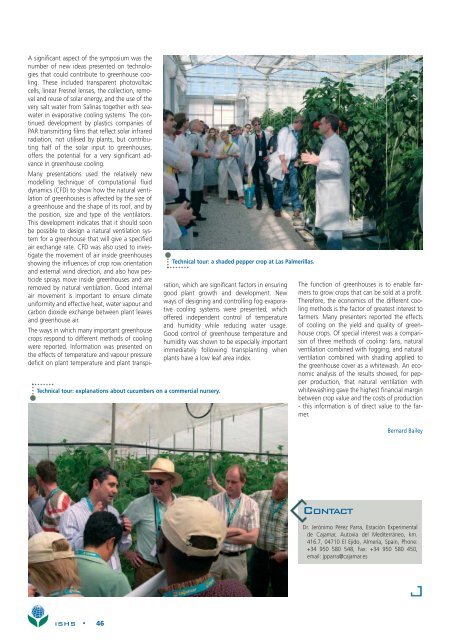Acta Horticulturae
Acta Horticulturae
Acta Horticulturae
Create successful ePaper yourself
Turn your PDF publications into a flip-book with our unique Google optimized e-Paper software.
Technical tour: explanations about cucumbers on a commercial nursery.<br />
Technical tour: a shaded pepper crop at Las Palmerillas.<br />
A significant aspect of the symposium was the<br />
number of new ideas presented on technologies<br />
that could contribute to greenhouse cooling.<br />
These included transparent photovoltaic<br />
cells, linear Fresnel lenses, the collection, removal<br />
and reuse of solar energy, and the use of the<br />
very salt water from Salinas together with seawater<br />
in evaporative cooling systems. The continued<br />
development by plastics companies of<br />
PAR transmitting films that reflect solar infrared<br />
radiation, not utilised by plants, but contributing<br />
half of the solar input to greenhouses,<br />
offers the potential for a very significant advance<br />
in greenhouse cooling.<br />
Many presentations used the relatively new<br />
modelling technique of computational fluid<br />
dynamics (CFD) to show how the natural ventilation<br />
of greenhouses is affected by the size of<br />
a greenhouse and the shape of its roof, and by<br />
the position, size and type of the ventilators.<br />
This development indicates that it should soon<br />
be possible to design a natural ventilation system<br />
for a greenhouse that will give a specified<br />
air exchange rate. CFD was also used to investigate<br />
the movement of air inside greenhouses<br />
showing the influences of crop row orientation<br />
and external wind direction, and also how pesticide<br />
sprays move inside greenhouses and are<br />
removed by natural ventilation. Good internal<br />
air movement is important to ensure climate<br />
uniformity and effective heat, water vapour and<br />
carbon dioxide exchange between plant leaves<br />
and greenhouse air.<br />
The ways in which many important greenhouse<br />
crops respond to different methods of cooling<br />
were reported. Information was presented on<br />
the effects of temperature and vapour pressure<br />
deficit on plant temperature and plant transpiration,<br />
which are significant factors in ensuring<br />
good plant growth and development. New<br />
ways of designing and controlling fog evaporative<br />
cooling systems were presented, which<br />
offered independent control of temperature<br />
and humidity while reducing water usage.<br />
Good control of greenhouse temperature and<br />
humidity was shown to be especially important<br />
immediately following transplanting when<br />
plants have a low leaf area index.<br />
The function of greenhouses is to enable farmers<br />
to grow crops that can be sold at a profit.<br />
Therefore, the economics of the different cooling<br />
methods is the factor of greatest interest to<br />
farmers. Many presenters reported the effects<br />
of cooling on the yield and quality of greenhouse<br />
crops. Of special interest was a comparison<br />
of three methods of cooling: fans, natural<br />
ventilation combined with fogging, and natural<br />
ventilation combined with shading applied to<br />
the greenhouse cover as a whitewash. An economic<br />
analysis of the results showed, for pepper<br />
production, that natural ventilation with<br />
whitewashing gave the highest financial margin<br />
between crop value and the costs of production<br />
- this information is of direct value to the farmer.<br />
Bernard Bailey<br />
CONTACT<br />
Dr. Jerónimo Pérez Parra, Estación Experimental<br />
de Cajamar, Autovia del Mediterráneo, km.<br />
416.7, 04710 El Ejido, Almería, Spain, Phone:<br />
+34 950 580 548, Fax: +34 950 580 450,<br />
email: jpparra@cajamar.es<br />
ISHS • 46
















